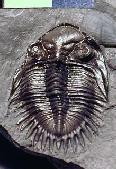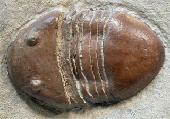|
 See More Images See More Images

Phacops rana
© 2003 Thomas Kammer

Neometacanthus
© 2001 Karl Wilson

Homotelus florencevillensis
© 2005 The Virtual Fossil Museum
|
What are Trilobites? Trilobites are perhaps the most famous and easily recognized fossil invertebrate group. The name comes from the length wise division of the body into three lobes—two side (pleural) lobes separated by one central (axial) lobe. All trilobites had antennae and legs with two branches, one used for locomotion and the other for respiration. Some had compound eyes, like a modern fly. Trilobites were strictly marine animals, but they were very diverse, living in both shallow and deep waters. First known fossil occurrence: Cambrian. Last known fossil occurrence: Permian. |
Fossils through time:
Choose a time period to see what life was like:
|
|